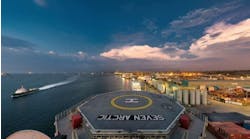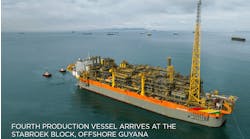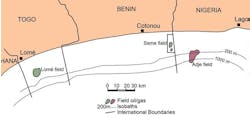Drillship overcoming initial problems
William Furlow
Technology Editor
The Glomar Explorer, shrugging off early shakedown problems, sets its sights on a well in 8,000-ft water depths.The Glomar Explorer wasted little time in establishing itself as the world's premiere ultra-deepwater drillship. Overcoming a variety of delays, and malfunctions, the vessel set a new water depth record late last year and with time and experience under its belt, it soon may attempt to beat this record by drilling in over 8,000 ft of water.
The road to this record was by no means smooth, but when one considers the drillship was the first of the new generation of ultra-deepwater vessels now making their way to the market. Problems encountered early in operations may provide useful information for other ultra-deep vessels currently scheduled for delivery.
While there will eventually be a number of rigs that can match the capabilities of the Glomar Explorer, none of the newbuilds should ever be able to achieve such historical significance. Built for the US Central Intelligence Agency by Global Marine at the height of the Cold War, the vessel began its career by recovering parts of a Russian submarine from the middle of the Pacific Ocean. The mission, to this day, is largely shrouded in secrecy.
After this mission, code named Jennifer Project, was completed, the vessel was mothballed in California for more than 20 years. When the demand for deepwater drilling vessels began to grow, Global Marine made a deal with the US Navy to buy the ship back and undertake a massive renovation program. The renovation allowed the vessel to become the first ultra-deepwater unit to hit the market.
Delivery delays
The Glomar Explorer was originally equipped with a state-of-the-art dynamic positioning (DP) system, for the 1970s. This, was replaced with a new DP system that had to be integrated with the existing systems and other new systems on the vessel. This caused more than a few systems integration headaches.The rig was originally scheduled for delivery in April of last year. The installation of new systems and the integration of these with the existing equipment pushed this date back. On the bridge, the 1970s helm with its classic manual controls and analog dials is now juxtaposed with the DP system that would look at home on the deck of a space ship.
In addition to the DP system, the pipe handling system was modified to improve reliability. A new riser handling system and horizontal racking system were added. This horizontal racking system is unusual, but taking the pipe out of the derrick allowed the vessel to utilize a smaller derrick and be more stable. This system can rack back 30,000 ft of 5.5-in. drillpipe in triple stands. The bottom hole assembly and landing string are still racked back in the derrick, as are double strings of casing, but removing all this drillpipe makes for less congestion in the derrick and faster tripping.
Rig manager Jim Long said the vessel was held to some very high acceptance criteria not only by Global Marine, by its initial clients, Chevron and Texaco. The plan was to have a rig that is 100% complete at delivery. Long said it is common for a new rig to be finished up on site. Because of the extreme nature of the vessel's first assignment, drilling in a record water depth, it was essential that Global deliver a rig that was debugged and ready for action.
Overcoming problems
Among the innovations on the Glomar Explorer was a new blow out preventer system, designed by Cameron. Long said during the testing of the 18 3/4 TL preventer ram block, guidance problems caused scoring on the top seal area of the rams. This scoring was bad enough that the BOP had to be returned to Cameron to be welded up, heat treated, and re-machined.Also the emergency disconnect system was new to Cameron and the "deadman shut-in" systems were new to the entire industry. Basically this was a system that defaulted in the closed position, so that if the riser
is parted during an emergency disconnect, the rams will close automatically, shutting in the well. This system had to be perfected before the rig could lower the BOP package.
In the beginning of June, while waiting on the BOP, the vessel completed 90% of its sea trials. The vessel stayed at sea 10 days longer than planned to fine tune its systems while waiting for the BOP. It was at this time that the company discovered a leaking seal on one of its DP thrusters. This would ultimately be determined to be a seal installation problem, but not before the thruster was replaced twice. Initially, it was hoped the vessel could wear the seal in by running the thruster, but the vessel was forced back into dry dock to replace the seal, which again leaked, leading the discovery that this was a seal installation problem.
First well spudded
On August 9 1998, the Glomar Explorer went on station with a new BOP stack and drilled the first section of its world-record depth well. At this time, the thruster was still giving them trouble, so it was decided to drill the first stage of the well, and set 20-in. casing. The vessel would then move onto the second well, 22 miles away, and spud and drill the first section of this well. Neither of these wells required a BOP stack at this depth, which reduced the DP requirements because an open hole offers a broader watch circle than one with a landed BOP stack. Long said he is confident the vessel could stay on station despite the bad thruster, but it was decided to take a more conservative approach.On September 13, a problem occurred with the riser elevator which carries riser strings from a storage bay up 30 ft to the drill floor. While two workers were checking out the problem, the brakes failed on the elevator and it dropped back to the bottom of the bay. Although the workers were injured, the elevator did not land on them. Their injuries were caused by being thrown around the maintenance deck of the elevator. Both men are expected to fully recover.
This malfunction brought the vessel back into drydock for a month, at which time the thruster was replaced for the final time and the problem properly identified.
The Glomar Explorer returned to Atwater Valley 118, the site of its first well, on October 15 and completed that well in the world's record depth of 7,718 ft. The vessel then returned to the second well it spudded on Mississippi Canyon 772 where it is now drilling in a relatively shallow 5,500 ft of water.
Lessons learned
Long said the experiences gained in the shakedown of the Glomar Explorer will increase the efficiency of the rig and be beneficial to the rest of the industry as new vessels of this size begin to reach the market.Copyright 1999 Oil & Gas Journal. All Rights Reserved.




